Page 105 of 207
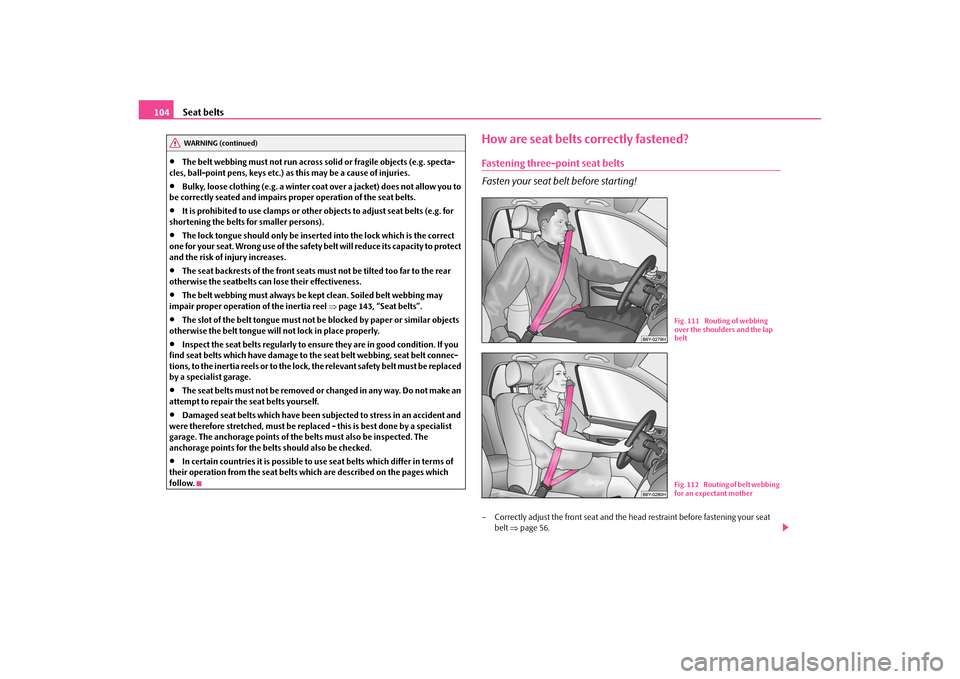
Seat belts
104
The belt webbing must not run across solid or fragile objects (e.g. specta-
cles, ball-point pens, keys etc.) as this may be a cause of injuries.
Bulky, loose clothing (e.g. a winter coat over a jacket) does not allow you to
be correctly seated and impairs pr oper operation of the seat belts.
It is prohibited to use clamps or other objects to adjust seat belts (e.g. for
shortening the belts for smaller persons).
The lock tongue should only be inserted into the lock which is the correct
one for your seat. Wrong use of the safety belt will reduce its capacity to protect
and the risk of injury increases.
The seat backrests of the front seats must not be tilted too far to the rear
otherwise the seatbelts can lose their effectiveness.
The belt webbing must al ways be kept clean. Soiled belt webbing may
impair proper operation of the inertia reel page 143, “Seat belts”.
The slot of the belt tongue must not be blocked by paper or similar objects
otherwise the belt tongue will not lock in place properly.
Inspect the seat belts regularly to ensure they are in good condition. If you
find seat belts which have damage to th e seat belt webbing, seat belt connec-
tions, to the inertia reels or to the lock, the relevant safety belt must be replaced
by a specialist garage.
The seat belts must not be removed or changed in any way. Do not make an
attempt to repair the seat belts yourself.
Damaged seat belts which have been subjected to stress in an accident and
were therefore stretched, must be replaced - this is best done by a specialist
garage. The anchorage points of the belts must also be inspected. The
anchorage points for the belts should also be checked.
In certain countries it is possible to use seat belts which differ in terms of
their operation from the seat belts wh ich are described on the pages which
follow.
How are seat belts correctly fastened?Fastening three-point seat belts
Fasten your seat be lt before starting!– Correctly adjust the front seat and the he ad restraint before fastening your seat
belt page 56.
WARNING (continued)
Fig. 111 Routing of webbing
over the shoulders and the lap
beltFig. 112 Routing of belt webbing
for an expectant mother
s2rc.book Page 104 Thursday, April 22, 2010 10:58 AM
Page 106 of 207

Seat belts105
Using the system
Safety
Driving Tips
General Maintenance
Breakdown assistance
Technical Data
– Slowly pull the belt webbing at the tongue
of the lock over your chest and pelvis
.
– Insert the tongue of the lock into the seat belt buckle belonging to the seat until it is heard to lock in place.
– Pull on the belt to check that it has also reliably engaged in the lock.
Each three-point seat belt is equipped with an inertia reel. This inertia reel offers you
complete freedom of movement if the belt is unreeled slowly. If the brakes are applied
suddenly, the inertia reel will block. It also blocks the belts when the car accelerates,
when driving uphill and when cornering.
Expectant mothers must also wear the seat belt .
WARNING
The shoulder part of the seat belt must never run across your neck but must
run approximately over the middle of the shoulder and fit snugly against the
chest. The lap part of the belt must run across the hip and must never be routed
across the stomach. It must always fit snugly page 104, fig. 111 . Adjust the
belt webbing as required.
The lap part of the belt should be positioned as low as possible at the pelvis
of an expectant mother in order to avoid exerting any pressure on the lower
abdomen.
Always ensure that the webbing of the seat belts is properly routed. Seat
belts which are not correctly adjusted ca n themselves cause injuries even in
minor accidents.
A seat belt which is hanging too loose can result in injuries as your body is
moved forward by the kinetic energy produced in an accident and is then
suddenly held firm by the belt.
Only insert the lock tongue into the lock which is the correct one for your
seat. This will affect the protection which the belt offers and increase the risk of
an injury.
Seat belt height adjusterThe seat belt height adjuster makes it possible for you to adapt the routing of the three-
point seat belt in the area of the shoulder to match your body size.
– In order to adjust the height, press on the upper seat belt deflection and push it into the desired direction up or down so th at the shoulder part of the belt is posi-
tioned approximately across th e middle of your shoulder page 104, fig. 111 .
– Then pull firmly on the belt to ensure that the seat belt height adjuster has correctly
locked in place.
WARNING
Adjust the height of the belt in such a way that the shoulder part of the belt is
positioned approximately across the middle of your shoulder - on no account
across your neck.
Note
It is also possible to adapt the routing of the belt webbing at the front seats by adjusting
the height of the seat.
Fig. 113 Front seat: Seat belt
height adjuster
s2rc.book Page 105 Thursday, April 22, 2010 10:58 AM
Page 107 of 207

Seat belts
106
Taking seat belts off– Press the red button in the belt lock fig. 114 . The spring force causes the tongue
of the lock to jump out.
– Guide the belt back with your hand to en able the inertia reel to wind up the belt
webbing more easily.
A plastic knob in the belt webbing holds the be lt tongue in a position which is easy to
get hold of.Three-point seat belt with the Interlock System*A three-point safety belt with the Interlock System is used on some vehicles instead of
a pelvic belt.
If the backrest of the rear seats is not secured, the retractor blocks and the seat belt
cannot be reeled down.Rear middle three-point safety belt with safety lock for a child seat*In order to attach a child seat the rear middle three-point safety belt with the blocking,
the so-called child safety locks, can be used.
Switching child safety lock on– Attach the child safety seat with the three-point seat belt (self-retracting) as stated
in the manufacturer's instructions.
– Reel up the shoulder part of the belt comp letely. When the belt is reeled up, this
can be detected by a “clicking” noise.
– After fixing the child seat in place, let th e belt freely reel up. Now the belt can no
longer be reeled down.
– Check if the safety lock is activated by pulling on the belt.Switching child safety lock off– By pressing the button in the lock of the safety belt, the blocking is unblocked and
afterwards the safety belt starts to reel up.
– After fully reeling up the belt, you can freely reel it down again.The pelvic belt*
Fig. 114 Releasing lock tongue
from belt lock
Fig. 115 Fasten pelvic belt
s2rc.book Page 106 Thursday, April 22, 2010 10:58 AM
Page 108 of 207

Seat belts107
Using the system
Safety
Driving Tips
General Maintenance
Breakdown assistance
Technical Data
The rear middle seat is fitted with a pelvic be
lt. The lock part of the two-point pelvic belt
is operated in the same way as for a three-point safety belt. An unused pelvic belt
should be stowed away together with the lock for safety reasons.
Extending the pelvic belt– Hold the lock tongue at right angles to the belt webbing and pull through the
desired amount of belt webbing fig. 116 .Shortening the pelvic belt– Pull on the free end of the belt.
– Fix the excess belt length by thre ading it through the plastic slider.
The adjustment of the belt length is facili tated by simultaniously pressing the belt
tongue and the belt cover lengthwise.
WARNING
The pelvic belt must always sit firmly ac ross the pelvis; tighten the belt webbing
if necessary.
Belt tensionersSafety for the driver and front passenger wearing their seat belts is enhanced by the
belt tensioners fitted to the inertia reels of the front three-point seat belts, in addition
to the protection afforded by the airbag system.
The three-point seat belts are automatically te nsioned in the event of a frontal collision
of a certain severity. The belt tensioners can also be deployed if the seat belts are not
fastened.
The belt tensioner is deployed in the event of a frontal collision of major severity. A
powder charge is ignited in the inertia re els during deployment. The belt webbing is
pulled into the inertia reels by a mechanical system and the belt is tensioned.
Belt tensioners are not activated in the even t of minor frontal collisions, side and rear-
end collisions, in the case of a rollover an d also not in accidents in which no major
forces are produced from the front.
WARNING
Any work on the system including removal and installation of system
components because of other repair work, must only be carried out by a
specialist garage.
The protective function of the system is only adequate for a single accident.
If the belt tensioners have been deployed, it is then necessary to replace the
entire system.
The Owner's Manual must also be handed over to the new owner if the
vehicle is sold.Note
Smoke is generated when the belt tensione rs are deployed. This is not an indica-
tion of a fire in the vehicle.
It is essential to pay attent ion to relevant safety regulations if the vehicle or indi-
vidual parts of the system are scrapped. Specialist garages are familiar with these regu-
lations and will be able to provide you with detailed information in this respect.
When disposing of vehicle or parts of the system, it is important to comply with the
national legal requirements.
Fig. 116 Extending the pelvic
belt
s2rc.book Page 107 Thursday, April 22, 2010 10:58 AM
Page 109 of 207

Airbag system
108
Airbag systemDescription of the airbag systemGeneral information on the airbag systemThe front airbag system is complementary to the three-point seat belts and offers
additional protection for the head and chest area of the driver and passenger in the
event of a frontal collision.
In the case of a violent side cr ash, the side airbags* reduce the risk of injuries to the
occupants on the side of the collision .
The airbag system is only functional af ter the ignition has been switched on.
The operational readiness of the airbag syst em is monitored electronically. The airbag
indicator light comes on for a few seconds each time the ignition is switched on.
The airbag system (according to vehicle equipment) consists of:
an electronic control unit,
front airbag for the driver and the front seat passenger*,
side airbags*,
an airbag indicator light in the instrument cluster,
Switch for front passenger airbag* in front passenger storage compartment
page 113,
Indicator light for a switched off front seat passenger airbag* page 113.
A fault in the airbag system exists if:
the airbag indicator light does not light up when the ignition is switched on,
the warning light does not go out after about 4 seconds after the ignition is
switched on,
the airbag indicator light goes out and come s on again after the ignition is switched
on,
the airbag indicator light comes on or flickers when driving.
WARNING
To enable the occupants of a vehicle to be protected with the greatest
possible effect when the airbag is deployed, the front seats must be page 98,
“Correct seated position” correctly adjusted to match the body size of the occu-
pant.
If you do not fasten the seat belts when driving, lean too far forward or
adopt an incorrect seated position, you are exposing yourself to increased risk
of injury in the event of an accident.
Have the airbag system checked immediat ely by a specialist garage if a fault
exists. Otherwise, there is a risk of the airbag not being activated in the event of
an accident.
No modifications of any kind may be made to parts of the airbag system.
It is prohibited to manipulate individual parts of the airbag system as this
might result in the airbag being deployed.
The protective function of the airbag system is sufficient for only one acci-
dent. The airbag system must then be re placed if the airbag has been deployed.
The airbag system needs no maintenance during its working life.
If you sell your car, please hand ov er the complete vehicle documentation
to the new owener. Please note that the documents relating to the possibility of
deactivating the front passenger airbag are also part of the vehicle documents!
If the vehicle or individual parts of the airbag system are scrapped, it is
essential to observe the relevant safety precautions. Specialist garages are
familiar with these regulations.
When disposing of vehicle or parts of the airbag system, it is important to
comply with the national legal requirements.
When are the airbags deployed?The airbag system is designed in such a way that the driver and the front passenger
airbag* are deployed in the event of a frontal collision of major severity.
s2rc.book Page 108 Thursday, April 22, 2010 10:58 AM
Page 110 of 207

Airbag system109
Using the system
Safety
Driving Tips
General Maintenance
Breakdown assistance
Technical Data
In the case of a
violent side crash , the side airbag* is depl oyed on the side of the
vehicle on which the collision occurs.
In certain accident situ ations, the front as well as the side airbags are deployed at the
same time.
The airbags are not deployed in the case of minor frontal and side collisions, in the
case of rear-end collisi ons and vehicle rollover.
Deployment factors
It is not possible to state globally which deployment conditions apply to the airbag
system in every situation as the circumstances which exist in the case of accidents vary
greatly. An important role in this case, for ex ample, is played by factors such as the type
of object against which the vehicle impacts (h ard, soft), the angle of impact, the vehicle
speed etc.
A decisive factor for the deployment of the airbags is the deceleration which occurs
during a collision. The control unit analyses the nature of the collision and activates the
relevant restraint system. If the vehicle deceleration which occurs and is measured
during the collision remains below the prescribed reference values specified in the
control unit, the airbags are no t deployed although the vehicle may well suffer severe
damage to the bodywork as a consequence of the accident.
The airbags are not deployed if:
ignition is switched off;
a minor frontal collision;
a minor side collision;
a rear-end collision;
Rollover of the vehicle.Note
A grey white, non harmful gas is released when airbag is inflated. This is perfectly
normal and is not an indicati on of a fire in the vehicle.
The dash panel must be replaced after the front passenger airbag has been
deployed.
In the event of an accident in which the airbags are deployed:
the interior lighting comes on (if the swit ch for the interior light is in the door
contact position),
the hazard warning li ght is switched on;
All the doors are unlocked.
Front airbagsDescription of the front airbags
The airbag system is not a su bstitute for the seat belt!The front airbag for the driver is housed in the steering wheel fig. 117 . The front
airbag for the front passenger* is housed in the dash panel above the storage
Fig. 117 Driver airbag in the
steering wheelFig. 118 Front passenger airbag
in the dash panel
s2rc.book Page 109 Thursday, April 22, 2010 10:58 AM
Page 111 of 207

Airbag system
110
compartment fig. 118. The installation positions are each marked with the
“AIRBAG” logo.
The front airbag system, in combination with three-point safety belts, offers additional
protection for the head and chest area of the driver and front passenger in the event
of a frontal collision of major severity in “Important safety information regarding
the front airbag system” on page 110.
The airbag is not a substitute for the seat belt, but is part of the complete passive
vehicle safety concept. Please note that an airbag can only offer you optimal
protection in combination with a seat belt which is fastened .
Apart from their normal protective function, a further task of the seat belts is to also
hold the driver and front passenger in a correct seated position in the event of a frontal
collision so as to enable the front ai rbags to offer the maximum protection.
You should therefore always fasten the seat be lts, not only because this is required by
law, but also for safety reasons and for your own protection page 102, “Why seat
belts?”.
Note
The dash panel must be replaced after the front passenger airbag has been
deployed.Function of the front airbags
Risk of injury to the head and ches t area is reduced by fully inflated
airbags.
The airbag system is designed in such a way that the driver and the front passenger
airbag* are deployed in the event of a frontal collision of major severity.
In certain accident situations, the front an d side airbags may be deployed together.
If the airbags are deployed, the airbags are filled with a propellant gas and inflated in
front of the driver and front passenger fig. 119 . The airbags inflate in fractions of a
second and at a high speed in order to be able to offer that additional protection in the
event of an accident. The forward movement of the driver and of the front passenger
i s c us h i o n e d w h e n th e y m a ke co n t a c t w i t h t h e f u l l y i n f l a t e d a i r ba g a n d th e r i s k o f i n j u r y
to head and chest is thus reduced.
The specially developed airbag allows the gas to flow out of the inflated airbag in a
controlled manner (depending on the load of the particular car occupant) in order to
cushion head and chest areas. The airbag then deflates subsequently to such an extent,
after an accident, to again provide a clear view forward.
A grey white, non harmful gas is released when airbag is inflated. This is perfectly
normal and is not an indicati on of a fire in the vehicle.
The airbag develops enormous forces when triggered, which can lead to injuries if the
sitting position or seated position is not correct in “Important safety information
regarding the front airbag system”.Important safety information regarding the front airbag system
Correct use of the airbag system cons iderably reduces the risk of injury!
Fig. 119 Inflated airbags
Fig. 120 Safe distance to
steering wheel
s2rc.book Page 110 Thursday, April 22, 2010 10:58 AM
Page 112 of 207

Airbag system111
Using the system
Safety
Driving Tips
General Maintenance
Breakdown assistance
Technical Data
WARNING
Never transport children on the front seat of a vehicle without using a
proper restraint system. If airbags are de ployed in the event of an accident, the
child might suffer severe or even fatal injuries!
For the driver and front passenger it is important to maintain a distance of
at least 25 cm from the steering wheel or dash panel page 110, fig. 120 . Not
maintaining this minimum distance will mean that the airbag system will not
be able to properly protect you - hazard! The front seats and the head restraints
must always also be correctly adjusted to match the body size of the occupant.
It is essential to always switch off the front passenger airbag and/or side
airbag when attaching a child safety seat on the front passenger seat where the
child is seated with its back facing in direction of travel (in some countries also
when the child is facing the direction of travel) page 113, “Deactivating an
airbag”. If this is not done, there is a ri sk of the child suffering severe or even
fatal injuries if the front passenger airbag is deployed. In certain countries
national legal provisions also require that the side passenger airbags be deac-
tivated. When transporting a child on the front passenger seat, please comply
with the appropriate national regulati ons regarding the use of child safety
seats.
There must not by any further persons, animals or objects positioned
between the front seated occupants and the deployment area of the airbag.
The steering wheel and the surface of the airbag module in the dash panel
on the passenger side must not be stuck onto, covered or modified in any other
way. These parts should only be cleaned with a dry cloth or a cloth moistened
with water. No objects such as cup holders, mobile phone mounts, etc. may be
attached to the covers of the airbag modules or be located within the imme-
diate area.
No modifications of any kind may be made to parts of the airbag system.
Any work on the airbag system includ ing installing and removing system
components because of other repair wo rk (e.g. removing the steering wheel)
must only be carried out by a specialist garage.
Never carry out changes on the front bumper or on the body.
Never place any objects on the surface of the front passenger airbag module
in the dash panel.
Side airbags*Description of side airbags
The side airbag increases protection of the passenger concerned in the
case of a side impact.The side airbags are housed in the upholstery of the seat backrests of the front seats.
The side airbag system in combination with the three-point seat belts, offers additional
protection for the upper area of the body (chest, stomach and pelvis) of the occupants
of the vehicle in the event of severe side collisions in “Important safety informa-
tion on the side airbag” on page 112.
Apart from their normal protective function, a further task of the seat belts is to also
hold the driver and front pass enger in a correct seated position in the event of a side
collision so as to enable the side ai rbags to offer the maximum protection.
You should therefore always fasten the seat belts, not only because this is required by
law, but also for safety reasons and for your own protection page 102, “Why seat
belts?”.
Fig. 121 Installation position of
side airbag in driver seat
s2rc.book Page 111 Thursday, April 22, 2010 10:58 AM
 1
1 2
2 3
3 4
4 5
5 6
6 7
7 8
8 9
9 10
10 11
11 12
12 13
13 14
14 15
15 16
16 17
17 18
18 19
19 20
20 21
21 22
22 23
23 24
24 25
25 26
26 27
27 28
28 29
29 30
30 31
31 32
32 33
33 34
34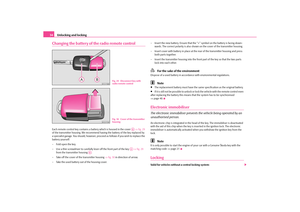 35
35 36
36 37
37 38
38 39
39 40
40 41
41 42
42 43
43 44
44 45
45 46
46 47
47 48
48 49
49 50
50 51
51 52
52 53
53 54
54 55
55 56
56 57
57 58
58 59
59 60
60 61
61 62
62 63
63 64
64 65
65 66
66 67
67 68
68 69
69 70
70 71
71 72
72 73
73 74
74 75
75 76
76 77
77 78
78 79
79 80
80 81
81 82
82 83
83 84
84 85
85 86
86 87
87 88
88 89
89 90
90 91
91 92
92 93
93 94
94 95
95 96
96 97
97 98
98 99
99 100
100 101
101 102
102 103
103 104
104 105
105 106
106 107
107 108
108 109
109 110
110 111
111 112
112 113
113 114
114 115
115 116
116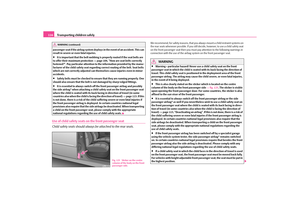 117
117 118
118 119
119 120
120 121
121 122
122 123
123 124
124 125
125 126
126 127
127 128
128 129
129 130
130 131
131 132
132 133
133 134
134 135
135 136
136 137
137 138
138 139
139 140
140 141
141 142
142 143
143 144
144 145
145 146
146 147
147 148
148 149
149 150
150 151
151 152
152 153
153 154
154 155
155 156
156 157
157 158
158 159
159 160
160 161
161 162
162 163
163 164
164 165
165 166
166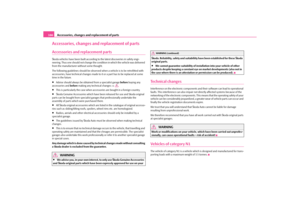 167
167 168
168 169
169 170
170 171
171 172
172 173
173 174
174 175
175 176
176 177
177 178
178 179
179 180
180 181
181 182
182 183
183 184
184 185
185 186
186 187
187 188
188 189
189 190
190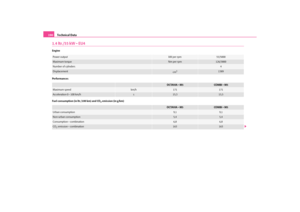 191
191 192
192 193
193 194
194 195
195 196
196 197
197 198
198 199
199 200
200 201
201 202
202 203
203 204
204 205
205 206
206






